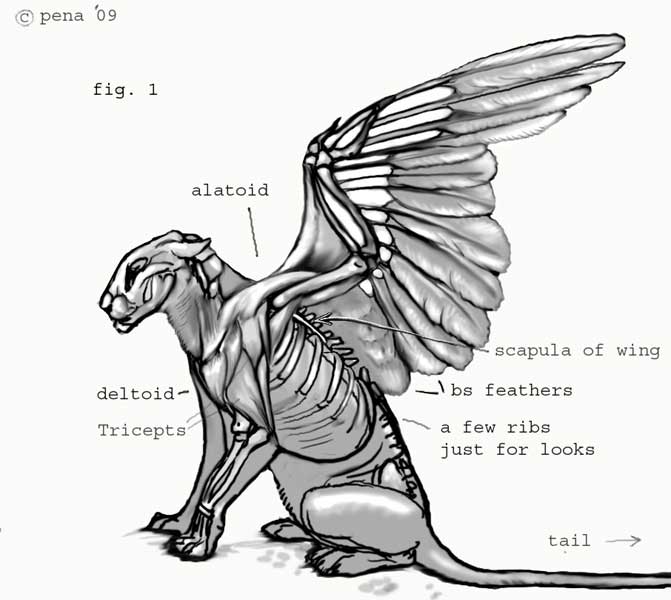
Certainly you all know that the biggest asset of a fantasy artist is the ability to successfully BS your way around impossible anatomy.
I have drawn a very inaccurate anatomical illustration here, of the hopelessly illogical anatomy of my winged lion. See how logical it looks? Right. That is the power of BS at work. The musculature of a bird’s wing is totally impossible to really do on a mammal or four legged creature and have it look right. You can leave the front legs off, or move them somewhere else, and try to explain that somehow, but…let’s face it, it just don’t work too well.
I go by the way I feel wings. If your human arms are wings for a moment here, when you lift them, you can feel the movement your trapezoids, rhomboids, and the whole suite of shoulder muscles that are attached to your scapula and arm. A bird can hardly move or use his scapular muscles at all. Some bird’s scapula’s are almost immobile in a groove against the spine, (next time you cook a whole chicken, check out where the scapula is placed ) so these muscles aren’t the ones a bird feels moving when it flies. But that doesn’t matter. We place ourselves into a fantasy creature, so it is the way our own musculature feels that I focus on. Therefore, the winged lion has no breast bone with huge pectorals attached, he has a new muscle that looks and feels like a human’s deltoid running from the top edge of the lion’s scapula, which serves as the imaginary collar bone area, to the first wing bone.This BS muscle is called the “alatoid”. This makes no sense whatsoever, but I know it is there because I can feel it. If you find yourself in the form of a winged lion with this anatomical arrangement you’d know exactly how to move your wing and you’d know how it would feel.There should also be “alatrapeziuses” “alarhomboids” and other BS muscles on the back of the winged lion’s wings that can be worked out, but I think it is far more pleasant to ignore them completely.
The next problem with sculpting four legged winged things is… what do you do with the space between the wing elbow and the body? On a bird this long “forearm” bone is usually almost half covered with the huge pectoral wing muscles which my lions and winged horses do not have, so either you need to shorten the bone, or cover it up with more BS. That is what all those feathers are good for. My winged lions and horses have conveniently adapted by growing a few extra primary-like feathers on on the forearm bone to fill in this area. This isn’t really such a stretch, since many seabirds really have these feathers . An example of this way of solving the problem can be found on the Pegasus character in the Disney Movie “Hercules”. He has short ( sort-of silly looking) primary like feathers on this area of his wings to fill it in. I know this is a very stylized Pegasus character, but fanciful or not, I empathize with the Disney artist who must of had a bit of struggle with the same problem!
This stuff is always the best part of fantasy art. The glorious BS.
